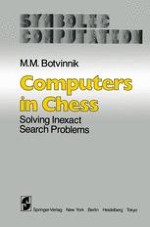
1984 | OriginalPaper | Buchkapitel
The General Statement
verfasst von : M. M. Botvinnik
Erschienen in: Computers in Chess
Verlag: Springer New York
Enthalten in: Professional Book Archive
Aktivieren Sie unsere intelligente Suche, um passende Fachinhalte oder Patente zu finden.
Wählen Sie Textabschnitte aus um mit Künstlicher Intelligenz passenden Patente zu finden. powered by
Markieren Sie Textabschnitte, um KI-gestützt weitere passende Inhalte zu finden. powered by
The notion of an inexact problem was introduced by the author several years ago [1], but no precise definition was then given. We now say that an enumerative task is inexact if it solves a problem by minimax methods on a truncated search tree (see the Glossary of Terms). The concepts of minimax procedure and search tree are well known; the concept of the truncated search tree may need explanation. Problems soluble by the formation of a tree of all possibilities (elementary actions) may differ in difficulty and may give rise to search trees of different sizes—small, large, or even infinitely large. If the resources of our information-processing device (speed and memory) are so limited that we cannot form the tree and search it exhaustively, we must either abandon the task or be content with an inexact (i.e., approximate) solution. If an inexact solution is acceptable, we limit the depth of the variations; the use of a depth-truncated tree and the acceptance of an approximate solution make the enumerative problem inexact. The definition of an inexact problem is therefore inextricably bound up with the general method of solution and with the resources of the information- processing system being used. If we can apply the minimax procedure to the complete tree, the problem is exact. (Problems may of course be solved exactly by other methods, e.g, by the use of equations or exact algorithms, and they may be inexact under other definitions, as when approximate solutions to equations are used. However, we shall use the narrow definition of an inexact task, as given above, and will not consider inexact tasks not conforming to it.